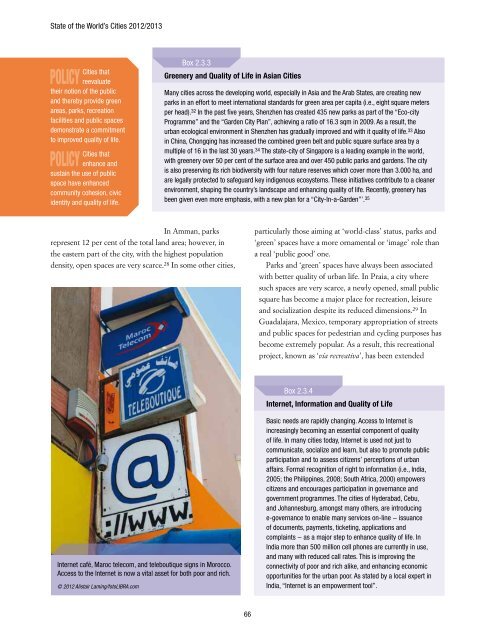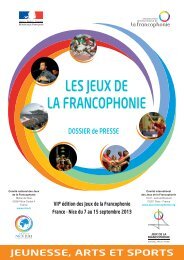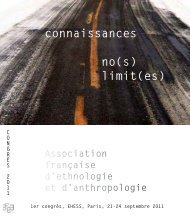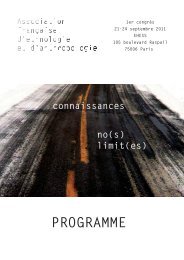Quality <strong>of</strong> Life and Urban ProsperityUN-Habitat has identified various areas <strong>of</strong> interventionwhich governments with different political orientations andlevels <strong>of</strong> development still consider as priority interventions:safety and security, efficient public transport, public spaces,healthcare and adequate housing, appear to be among <strong>the</strong>most important.Public Safety and Quality <strong>of</strong> Life: A safe and secure lifefor all is an integral component <strong>of</strong> a prosperous city. As anexpert in Nairobi <strong>state</strong>s, “quality <strong>of</strong> life only makes sensewhen <strong>the</strong>re is adequate security”. 19 Experts in 52 <strong>cities</strong> in<strong>the</strong> developing world agreed that this is <strong>the</strong> most importantfactor contributing to a sense <strong>of</strong> empowerment and a feelingthat one is part <strong>of</strong> a prosperous city. In Lima, for instance, asurvey on quality <strong>of</strong> life conducted by a citizens’ observatoryfound that 73 per cent <strong>of</strong> <strong>the</strong> population considers urbaninsecurity as <strong>the</strong> main problem that conspires against quality<strong>of</strong> life and prosperity. 20A survey on “urban lifestyles” conducted in 2010 byVeolia Observatory in seven <strong>cities</strong> in both developingand developed nations found that in three <strong>of</strong> <strong>the</strong>se <strong>cities</strong>(Chicago, London and São Paulo) insecurity appears as <strong>the</strong>most important problem, and in ano<strong>the</strong>r (Paris) it featuresas <strong>the</strong> third most important. 21By itself, security may not bring prosperity to any city,but its absence is fatal. Economic inequity and/or instabilitynurtures high perceptions <strong>of</strong> crime and violence in various<strong>cities</strong> around <strong>the</strong> world, and inadequate urban planning lawenforcement drives many high- and middle-class residentsinto gated communities and o<strong>the</strong>r guarded urban andsuburban enclaves 22 , creating pockets <strong>of</strong> prosperity. Thistype <strong>of</strong> privilege remains unaffordable to those on lowincomes, whose safety is <strong>of</strong>ten more at risk. Personal safetyis seriously detrimental to freedom, mobility, productivityand public interactions, all <strong>of</strong> which are crucial to ensuringa high quality <strong>of</strong> life.Crime and violence can hinder, and sometimes, paralyzeregional and national economies. High rates <strong>of</strong> violenceand insecurity in Kingston (Jamaica) and Nairobi (Kenya)have stultified <strong>the</strong> o<strong>the</strong>rwise thriving tourist sectors in<strong>the</strong>se countries. 23Even though urbaninsecurity is to large extentpolicy Effectivepublic<strong>the</strong> result <strong>of</strong> extremesafety is a fundamentalinequalities, it can also‘common good’ thatgenerate fur<strong>the</strong>r socialenhances quality <strong>of</strong> lifefor all, and is a major and spatial disparitiesfoundation <strong>of</strong> urban that restrain access toprosperity.employment, resourcesfactIn 19 <strong>cities</strong> out <strong>of</strong> <strong>the</strong> 52 surveyed by UN-Habitat, anoverwhelming majority <strong>of</strong> experts (more than 80 per cent)rated security to work and live freely as a major contributorto prosperity. In <strong>cities</strong> like Praia, Cebu, Algiers, Chongqing,Singapore, La Paz and Amman, nearly all experts rated security as‘contributing’ or ‘highly contributing’ to prosperity.and opportunities. Moreover, unsafe <strong>cities</strong> and perceptions<strong>of</strong> insecurity also lead to more fragmented, sprawled andcar-dependent urban environments. The fear <strong>of</strong> crime andviolence not only increases reliance on private automobilesthrough <strong>the</strong> proliferation <strong>of</strong> low-density, peri-urban gatedcommunities, it also deters<strong>the</strong> public from usingpublic transport.Nearly one-thirdExtensive provision fact <strong>of</strong> local experts in<strong>of</strong> public goods suchLatin America, 25 per centas parks, schools, basicin African <strong>cities</strong> and morethan 10 per cent in Asia andservices, sports facilities<strong>the</strong> Arab States said lackand community centres,<strong>of</strong> public security was notparticularly in more violent properly addressed in <strong>the</strong>irneighbourhoods, toge<strong>the</strong>r respective <strong>cities</strong>.with strong participationfrom local communities,has enabled Medellín toenhance safety through social cohesion.Reviving <strong>the</strong> public space: In a large number <strong>of</strong> <strong>cities</strong>,provision, preservation and improvement <strong>of</strong> public spacesremains a neglected agenda. According to a local expertin Panama City, “in practice, <strong>the</strong> concept <strong>of</strong> public spacedoes not exist”. 24 In Cebu, an expert mentions that “publicparks, playground areas and recreational facilities aregrossly inadequate”. 25 Ano<strong>the</strong>r in Al-Muharrak (Bahrain)<strong>state</strong>s that “<strong>the</strong> city has been losing green areas and today<strong>the</strong> proportion <strong>of</strong> gardens is small”. 26 As many o<strong>the</strong>rpublic goods, ‘green’ and open areas tend to be enclosed,restricted, or depleted by unsustainable use. In Amman,city authorities have been converting public areas andparks into developments.In India, confessionalgroups erect temples inMany public spacespublic parks; in Bangladeshfact are residual urbanareas that are exposeddevelopers constructto speculation for privatehousing in open publicpr<strong>of</strong>it. In o<strong>the</strong>r <strong>cities</strong>, publicareas; in Nairobi, private spaces remain concentratedinterests occupy riparian in <strong>the</strong> affluent areas.lands. 2765
State <strong>of</strong> <strong>the</strong> World’s Cities <strong>2012</strong>/<strong>2013</strong>policyCities thatreevaluate<strong>the</strong>ir notion <strong>of</strong> <strong>the</strong> publicand <strong>the</strong>reby provide greenareas, parks, recreationfacilities and public spacesdemonstrate a commitmentto improved quality <strong>of</strong> life.policyCities thatenhance andsustain <strong>the</strong> use <strong>of</strong> publicspace have enhancedcommunity cohesion, civicidentity and quality <strong>of</strong> life.Box 2.3.3Greenery and Quality <strong>of</strong> Life in Asian CitiesMany <strong>cities</strong> across <strong>the</strong> developing world, especially in Asia and <strong>the</strong> Arab States, are creating newparks in an effort to meet international standards for green area per capita (i.e., eight square metersper head). 32 In <strong>the</strong> past five years, Shenzhen has created 435 new parks as part <strong>of</strong> <strong>the</strong> “Eco-cityProgramme” and <strong>the</strong> “Garden City Plan”, achieving a ratio <strong>of</strong> 16.3 sqm in 2009. As a result, <strong>the</strong>urban ecological environment in Shenzhen has gradually improved and with it quality <strong>of</strong> life. 33 Alsoin China, Chongqing has increased <strong>the</strong> combined green belt and public square surface area by amultiple <strong>of</strong> 16 in <strong>the</strong> last 30 years. 34 The <strong>state</strong>-city <strong>of</strong> Singapore is a leading example in <strong>the</strong> world,with greenery over 50 per cent <strong>of</strong> <strong>the</strong> surface area and over 450 public parks and gardens. The cityis also preserving its rich biodiversity with four nature reserves which cover more than 3.000 ha, andare legally protected to safeguard key indigenous ecosystems. These initiatives contribute to a cleanerenvironment, shaping <strong>the</strong> country’s landscape and enhancing quality <strong>of</strong> life. Recently, greenery hasbeen given even more emphasis, with a new plan for a “City-In-a-Garden”’. 35In Amman, parksrepresent 12 per cent <strong>of</strong> <strong>the</strong> total land area; however, in<strong>the</strong> eastern part <strong>of</strong> <strong>the</strong> city, with <strong>the</strong> highest populationdensity, open spaces are very scarce. 28 In some o<strong>the</strong>r <strong>cities</strong>,particularly those aiming at ‘world-class’ status, parks and‘green’ spaces have a more ornamental or ‘image’ role thana real ‘public good’ one.Parks and ‘green’ spaces have always been associatedwith better quality <strong>of</strong> urban life. In Praia, a city wheresuch spaces are very scarce, a newly opened, small publicsquare has become a major place for recreation, leisureand socialization despite its reduced dimensions. 29 InGuadalajara, Mexico, temporary appropriation <strong>of</strong> streetsand public spaces for pedestrian and cycling purposes hasbecome extremely popular. As a result, this recreationalproject, known as ‘vía recreativa’, has been extendedBox 2.3.4Internet, Information and Quality <strong>of</strong> LifeInternet café, Maroc telecom, and teleboutique signs in Morocco.Access to <strong>the</strong> Internet is now a vital asset for both poor and rich.© <strong>2012</strong> Alistair Laming/fotoLIBRA.comBasic needs are rapidly changing. Access to Internet isincreasingly becoming an essential component <strong>of</strong> quality<strong>of</strong> life. In many <strong>cities</strong> today, Internet is used not just tocommunicate, socialize and learn, but also to promote publicparticipation and to assess citizens’ perceptions <strong>of</strong> urbanaffairs. Formal recognition <strong>of</strong> right to information (i.e., India,2005; <strong>the</strong> Philippines, 2008; South Africa, 2000) empowerscitizens and encourages participation in governance andgovernment programmes. The <strong>cities</strong> <strong>of</strong> Hyderabad, Cebu,and Johannesburg, amongst many o<strong>the</strong>rs, are introducinge-governance to enable many services on-line − issuance<strong>of</strong> documents, payments, ticketing, applications andcomplaints − as a major step to enhance quality <strong>of</strong> life. InIndia more than 500 million cell phones are currently in use,and many with reduced call rates. This is improving <strong>the</strong>connectivity <strong>of</strong> poor and rich alike, and enhancing economicopportunities for <strong>the</strong> urban poor. As <strong>state</strong>d by a local expert inIndia, “Internet is an empowerment tool”.66





